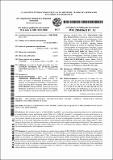Por favor, use este identificador para citar o enlazar a este item:
http://hdl.handle.net/10261/31588COMPARTIR / EXPORTAR:
 SHARE
BASE SHARE
BASE
|
|
| Visualizar otros formatos: MARC | Dublin Core | RDF | ORE | MODS | METS | DIDL | DATACITE | |

| Campo DC | Valor | Lengua/Idioma |
|---|---|---|
| dc.contributor.author | Obradors, Xavier | - |
| dc.contributor.author | Puig Molina, Teresa | - |
| dc.contributor.author | Granados, Xavier | - |
| dc.contributor.author | Lliescu, Adriana Simona | - |
| dc.contributor.author | Bartolomé, Elena | - |
| dc.contributor.author | Carrillo Fernández, Anna Esther | - |
| dc.date.accessioned | 2011-01-27T09:24:48Z | - |
| dc.date.available | 2011-01-27T09:24:48Z | - |
| dc.date.issued | 2004-06-29 | - |
| dc.identifier.citation | Wo 2004/063118 A1 | es_ES |
| dc.identifier.uri | http://hdl.handle.net/10261/31588 | - |
| dc.description | Fecha de solicitud:14.01.2004.- Titular: Consejo Superior de Investigaciones Científicas (CSIC). | es_ES |
| dc.description.abstract | [EN]The invention relates to a TrBCO/TrBCO-Ag/TrBCO superconducting material resulting from the artificial joining of monocrystalline ceramic parts having formula TrBa2Cu3O7-Tr2BaCuO5, wherein Tr corresponds to any rare-earth element or yttrium. The invention also relates to the method of joining the aforementioned parts, using a silver sheet or coating as a fluxing agent. The inventive method can be used to obtain materials with the same crystallographic orientation as the superconducting ceramic parts that are to be joined. Said method can also be used to produce superconducting ceramic parts with complex shapes in which, owing to the junctions, the critical currents remain as high as those of the original ceramics before being joined. The superconducting products thus produced can adopt complex shapes and, in this way, be integrated into different magnetic, electromagnetic and electromechanical devices with improved characteristics. [ES]La presente invención describe un material superconductor TrBCO/TrBCO-Ag/TrBCO resultante de la unión artificial de piezas cerámicas monocristalinas que responden a la fórmula TrBa2Cu3O7-Tr2BaCuO5 donde Tr corresponde con cualquier elemento de las denominadas Tierras raras o Ytrio. Asimismo se describe el procedimiento de unión de dichas piezas mediante el empleo de una lámina o un recubrimiento de plata como agente fundente. Dicho procedimiento permite obtener materiales con la misma orientación cristalográfica que las piezas cerámicas superconductoras que se desean unir. Este proceso permite fabricar productos cerámicos superconductores con formas complejas en los cuales las corrientes críticas a través de las uniones permanecen tan elevadas como las de las cerámicas originales antes de unirse. Los productos superconductores fabricados con dicha metodología pueden adoptar formas complejas y por lo tanto pueden ser integrados en dispositivos magnéticos, electromagnéticos y electromecánicos diversos con características mejoradas. | es_ES |
| dc.language.iso | spa | es_ES |
| dc.rights | openAccess | es_ES |
| dc.title | TRBCO/TRBCO-AG/TRBCO superconducting ceramic material, production method thereof and applications of same. | es_ES |
| dc.title.alternative | Material superconductor cerámico TRBCO/TRBCO-AG/TRBCO, su procedimiento de obtencion y sus aplicaciones. | es_ES |
| dc.type | patente | es_ES |
| dc.description.peerreviewed | Peer reviewed | es_ES |
| dc.type.coar | http://purl.org/coar/resource_type/c_15cd | es_ES |
| item.openairecristype | http://purl.org/coar/resource_type/c_18cf | - |
| item.fulltext | With Fulltext | - |
| item.cerifentitytype | Publications | - |
| item.openairetype | patente | - |
| item.languageiso639-1 | es | - |
| item.grantfulltext | open | - |
| Aparece en las colecciones: | (ICMAB) Patentes | |
Ficheros en este ítem:
| Fichero | Descripción | Tamaño | Formato | |
|---|---|---|---|---|
| WO2004063118A1.pdf | 1,41 MB | Adobe PDF |  Visualizar/Abrir |
CORE Recommender
Page view(s)
258
checked on 18-abr-2024
Download(s)
75
checked on 18-abr-2024
Google ScholarTM
Check
NOTA: Los ítems de Digital.CSIC están protegidos por copyright, con todos los derechos reservados, a menos que se indique lo contrario.
